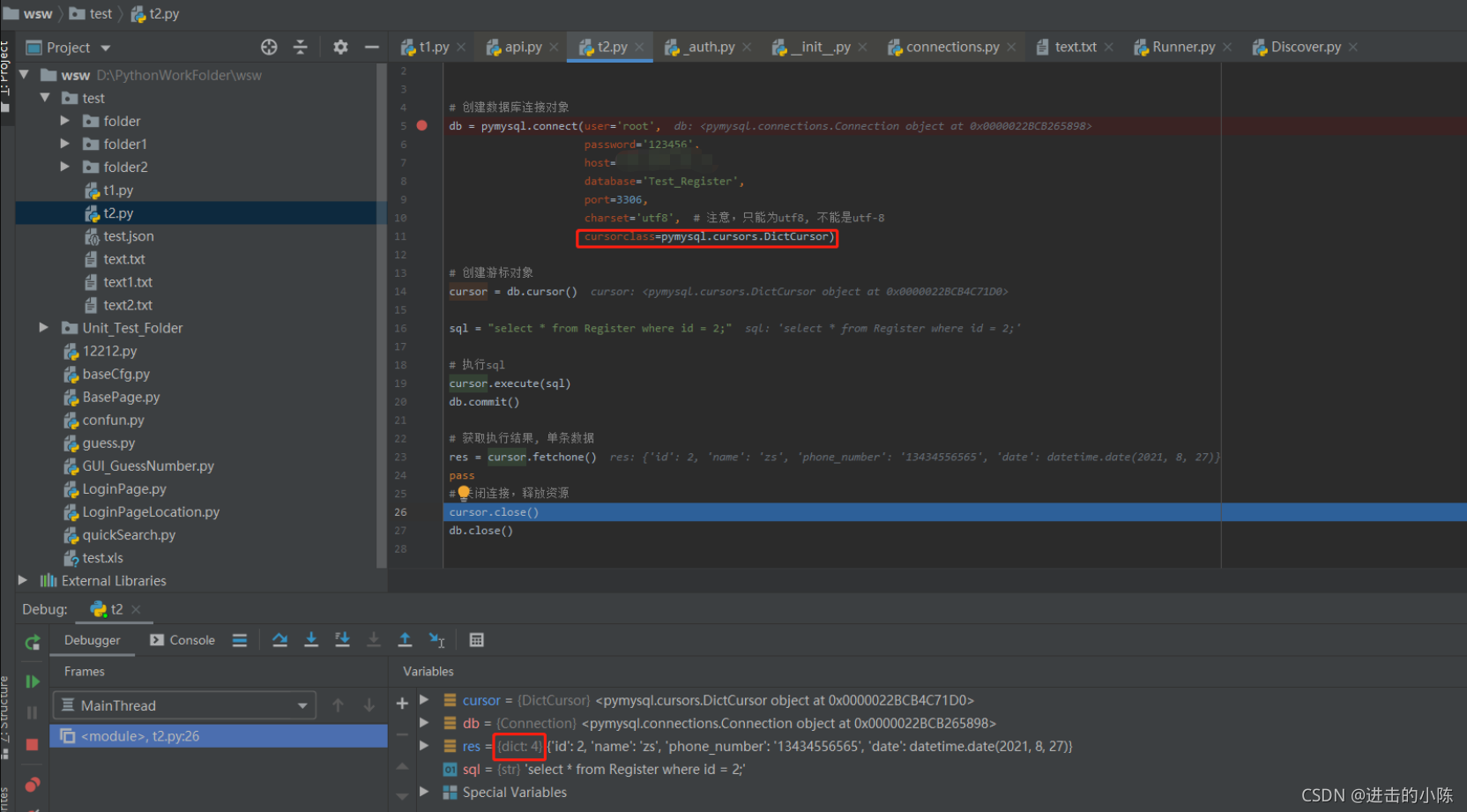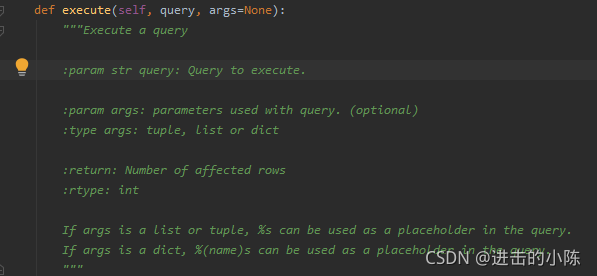- 1国产linux x64,腾讯重新发布QQ Linux版,完美适配中兴新支点国产操作系统
- 2阿里云----阿里云新买的数据盘如何挂载使用
- 3代码随想录刷题思路与心得06|454. 383. 15. 18._代码随想录怎么刷题java
- 4java计算机毕业设计基于springboo的高校大学生社团管理系统
- 5针对双非学生计算机保研信息分享_南大人工智能招双非吗
- 6解决eclipse中git中的cannot open git-upload-pack问题
- 7Java中的深拷贝和浅拷贝_深拷 和浅拷 java
- 8Mac电脑安装蚁剑_mac安装蚁剑
- 9NLP实践——以T5模型为例训练seq2seq模型_t5模型下载
- 10Git和Github详细入门教程(别再跟我说你不会Git和Github)_git and github 教程
python:pymysql的基本使用_pymysql cursorclass
赞
踩
安装
使用pip命令安装:pip install mymysql
上代码
import pymysql # 创建数据库连接对象 db = pymysql.connect(user='root', password='123456', host='ip', # 写你数据库的ip地址 database='Test_Register', port=3306, charset='utf8', # 注意,只能为utf8, 不能是utf-8 cursorclass=pymysql.cursors.DictCursor) # 创建游标对象 cursor = db.cursor() # 创建sql语句 sql = "select * from Register where id = 2;" # 要注意sql语句里要有分号,mysql是以分号为结束标志的 # 执行sql cursor.execute(sql) db.commit() # 获取执行结果, 单条数据 res = cursor.fetchone() # 关闭连接,释放资源, 先关闭游标,再关闭连接对象 cursor.close() db.close()
- 1
- 2
- 3
- 4
- 5
- 6
- 7
- 8
- 9
- 10
- 11
- 12
- 13
- 14
- 15
- 16
- 17
- 18
- 19
- 20
- 21
- 22
- 23
- 24
- 25
- 26
- 27
- 28
- 29
上面那段代码,可以看出,使用pymysql的步骤:
1.创建连接对象;
2.创建游标对象;
3.执行sql;
4.关闭游标、连接对象。
下面,我们再根据上段代码的执行顺序,依次进行说明。
创建连接对象时,connect的各项参数
pymysql.connections.Connection(self, host=None, # 要连接的主机地址 user=None, # 用于登录的数据库用户 password='', # 数据库密码 database=None, # 要连接的数据库名称 port=0, # 端口,一般默认端口为3306,要根据你数据库的实际端口写 unix_socket=None, # 选择是否要用unix_socket而不是TCP/IP charset='', # 字符编码,比如utf8,注意,要写utf8,而不是utf-8 sql_mode=None, # Default SQL_MODE to use. read_default_file=None, # 从默认配置文件(my.ini或my.cnf)中读取参数 conv=None, # 转换字典 use_unicode=None, # 是否使用 unicode 编码 client_flag=0, # Custom flags to send to MySQL. Find potential values in constants.CLIENT. cursorclass=<class 'pymysql.cursors.Cursor'>, # 选择 Cursor 类型 init_command=None, # 连接建立时运行的初始语句 connect_timeout=10, # 连接超时时间,(default: 10, min: 1, max: 31536000) ssl=None, # A dict of arguments similar to mysql_ssl_set()'s parameters.For now the capath and cipher arguments are not supported. read_default_group=None, # Group to read from in the configuration file. compress=None, # 不支持 named_pipe=None, # 不支持 no_delay=None, # 是否延迟 autocommit=False, # 是否自动提交事务 db=None, # 同 database,为了兼容 MySQLdb passwd=None, # 同 password,为了兼容 MySQLdb local_infile=False, # 是否允许载入本地文件 max_allowed_packet=16777216, # 限制 `LOCAL DATA INFILE` 大小 defer_connect=False, # Don't explicitly connect on contruction - wait for connect call. auth_plugin_map={}, # 我也不知道啥意思,希望有大佬给解释一下 read_timeout=None, # 读取超时时间 write_timeout=None, # 写入超时时间 bind_address=None # 当客户有多个网络接口,指定一个连接到主机 )
- 1
- 2
- 3
- 4
- 5
- 6
- 7
- 8
- 9
- 10
- 11
- 12
- 13
- 14
- 15
- 16
- 17
- 18
- 19
- 20
- 21
- 22
- 23
- 24
- 25
- 26
- 27
- 28
- 29
- 30
- 31
- 32
在这里,再举例解释一下cursorclass参数:
比如,我们直接使用上面那段代码进行调试,可以看到,执行sql之后,返回的res结果类型是字典类型:

当我们将cursorclass=pymysql.cursors.DictCursor 这行代码注释掉后,返回的res结果,则为元组。(其实也可以理解为,当创建连接对象时,不指定cursorclass时,返回的结果就是元组,指定时,则按照指定的类型返回)

cursor = db.cursor() 创建游标对象
我理解的,这是固定写法,创建完连接对象之后,一定要使用连接对象创建游标对象。
执行sql
cursor.execute(sql)
db.commit()
- 1
- 2
cursor.execute(sql) 这一句其实并没有真正的执行sql语句,就相当于枪已经上膛了,但是并没有发射出去,db.commit() 这一句代码执行之后,才是真正的执行了sql语句,所以,这两句代码要在一起执行。
cursor.execute(sql) 的execute方法,查看源代码知道,还可以进行传参,当我们不传入参数的时候,默认就是None,如果要传入args时,则需要传入元组,列表或字典。

还是以开始那段代码为例,将sql语句重新修改一下,经参数变为可变参数,然后execute执行时,将参数以元组的形式传入,代码如下:
import pymysql # 创建数据库连接对象 db = pymysql.connect(user='root', password='123456', host='ip', # 写数据库的地址 database='Test_Register', port=3306, charset='utf8', # 注意,只能为utf8, 不能是utf-8 cursorclass=pymysql.cursors.DictCursor) # 创建游标对象 cursor = db.cursor() sql = "select * from Register where id = %s and name = %s;" # 注意,这里参数可变时,必须使用%s代替 # 执行sql cursor.execute(sql, args=(2, 'zs')) db.commit() # 获取执行结果, 单条数据 res = cursor.fetchone() pass # 关闭连接,释放资源 cursor.close() db.close()
- 1
- 2
- 3
- 4
- 5
- 6
- 7
- 8
- 9
- 10
- 11
- 12
- 13
- 14
- 15
- 16
- 17
- 18
- 19
- 20
- 21
- 22
- 23
- 24
- 25
- 26
- 27
- 28
执行结果如下:

获取执行结果
上面几段代码使用的都是fetchone,意思只获取一条数据,但是,获取时,其实还有fetchmany和fetchall,分别是获取部分和获取全部:

fetchone(),上面代码均用的时fetchone(),但我们的sql语句也只能查出一条数据,下面再修改一下sql语句,可以查出多条数据:
import pymysql # 创建数据库连接对象 db = pymysql.connect(user='root', password='123456', host='ip', # 写数据库的地址 database='Test_Register', port=3306, charset='utf8', # 注意,只能为utf8, 不能是utf-8 cursorclass=pymysql.cursors.DictCursor) # 创建游标对象 cursor = db.cursor() sql = "select * from Register where id = %s or name = %s;" # 将and修改为or # 执行sql cursor.execute(sql, args=(2, 'ls')) # 传入的参数可以查出两条数据 db.commit() # 获取执行结果, 单条数据 res = cursor.fetchone() pass # 关闭连接,释放资源 cursor.close() db.close()
- 1
- 2
- 3
- 4
- 5
- 6
- 7
- 8
- 9
- 10
- 11
- 12
- 13
- 14
- 15
- 16
- 17
- 18
- 19
- 20
- 21
- 22
- 23
- 24
- 25
- 26
- 27
- 28
- 29

但是我们使用fetchone()时,也只会返回一条数据:

我们把fetchone()修改为fetchall()后,则会返回全部数据:

fetchmany()很少使用。
回滚
回滚:即在事务运行的过程中发生了某种故障,事务不能继续执行,系统将事务中对数据库的所有已完成的操作全部撤销,滚回到事务开始时的状态。




